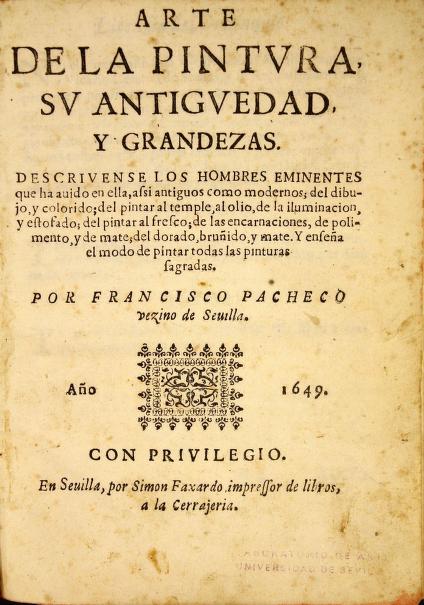
Frostispiece of Pacheco, El Arte de la pintura (1649), Seville, Simon Faxardo, impressor de libros, a la Cerrajeria
Following Molanus’s studies, Pacheco confirms that the saint can be depicted with his armour knight, with the sign of the Cross, the sword, and the spear. Also, in an allegorical representation, painting the saint as a maiden with a lamb, is also possible.
“What Molanus warns about his painting, which seems to allow the Church for its sinification, and we use it, because by it this holy martyr is known in his armour knight, defended maiden and dead dragon, is because he delivered many from the mouth of the infernal dragon, who passed to glory by martyrdom, sacrificing to God their own lives. And with the sign of the Cross, he cast the demon out of the idol of Apollo and converted to the faith of the Empress, Alexandra, wife of Diocletian, and for this reason, the sword and spear are attributed to him. Others paint him as a maiden with a lamb. By this allegorical painting, says Molanus, we are taught that we must work as soldiers of Christ to bring others to the faith, against the opposition of heretics and infidels, his enemies, and, in the first place to defend the Virgin Church and Bride of the spotless Lamb. […] Apart from these apparitions, Roman arms can be used in his painting for the veneration of antiquity as we see in the painting of the angels; this was done by Julius Romanus and Pompeius Aquilanus, and others in their prints.”.
“Lo que advierte Molano acerca de su pintura, la cual parece permitir la Iglesia por su sinificación, y nosotros la usamos, porque por ella es conocido este santo mártir en su armadura caballero, defendida doncella y dragón muerto, es porque libró a muchos de la boca del dragón infernal, que pasaron a la gloria por el martirio, sacrificando a Dios sus propias vidas. Y con la señal de la Cruz echó al demonio del idolo de Apolo y convirtió a la fe a la Emperatriz, Alexandra, mujer de Diocleciano, y por esto se le atribuye la espada y lanza. Otros le pintan una doncella con un cordero. Por esta alegórica pintura, dice Molano, se nos enseña que debemos trabajar como soldados de Cristo para traer otros a la fe, contra la oposición de los herejes e infieles, sus enemigos, y, en primer lugar defender la iglesia Virgen y Esposa del Cordero inmaculado. […] Fuera destas apariciones, se puede usar en su pintura de armas romanas por la veneración de la antiguedad como advertimos en la pintura de los ángeles; así lo hizo Julio Romano y Pompeo Aquilano, y otros en sus estampas.”
Pacheco 1990, 685, fig. 74, 687,fig. 75



